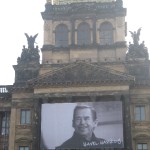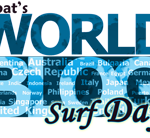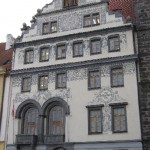
Yesterday, Tuesday 17th November 2009, marked the twentieth anniversary of the start of the events that led to the ‘Sametová Revoluce’, the Velvet Revolution, which saw the demise of the Communist government that had ruled Czechoslovakia for previous forty one years. As I mentioned in my recent blog post about Holidays and Celebrations in the Czech Republic, 17th November is now kept as a public holiday entitled ‘Struggle for Freedom and Democracy Day’.
Although not a Czech and having only lived here for 14 months, I was still interested to see how the momentous events of twenty years ago would be celebrated. So early yesterday afternoon, Sybille and I set out from our flat and travelled by bus and Metro to the centre of Prague, in order to soak up the atmosphere.
One thing the Czechs have become very good at is attaching a midweek public holiday to the nearest weekend and thus creating a long weekend. Therefore most schools and university faculties were also closed on Monday 16th as students and staff were granted a Headteachers/Deans holiday. As one Czech parent said to me, “If it wasn’t granted as a holiday, most people would take it as one anyway!”
However, in contrast to those enjoying a four-day weekend, most retail outlets were open on Tuesday. Our local Billa Supermarket had a notice declaring that on 17th November they would be open ‘normal Tuesday hours’. In Prague city centre, most shops, not just those aimed at tourists, were also open as normal for business. Twenty years on from the fall of communism, the capitalist free-market has well and truly established itself in the Czech Republic!

We went first to Staromestské námestí/Old Town Square where we understood various attractions had been laid on. We stupidly arrived two minutes too late and missed out on the thirty minute period when beer was being sold at the communist era price of just under 3 Kc for 0.5l. In UK terms that is about 10p a pint! However, we did enjoy some ham that had been freshly charcoal roasted over an open fire, accompanied by a cold beer. But for that privilege, we had to pay nearer the 2009 tourist price.
We then walked across to Václavské námestí/Wenceslas Square. At the Muzeum end of the square, were a series of display boards explaining in Czech and English, the events of 1989 that culminated in the capitulation of the Communist government and the election of the dissident playwright Václav Havel, as President on 29th December that year. The first of these events were students gathering in Wenceslas Square to mark the twentieth anniversary of the self-immolation of Jan Palach on 19th January. This and subsequent gatherings in what has become known as ‘Palach Week’, were forcibly dispersed by the National Security Corps officers using batons and water cannons.

Between the site of the display boards and the towering statue of Sv. Václav/St. Wenceslas on his horse, there is a small memorial to Jan Palach and another self-immolator Jan Zajic. In front of the memorial, many people had laid flowers or lit votive candles and several more people came to light candles as we stood in silence in front of the memorial. It had just gone dark and the flickering light of the candles made for a quiet evocative atmosphere.
We then set off back down Wenceslas Square and turned left into Národní where the main action of the day was due to culminate. On 17th November 1989, a large group of students who were trying to march from Albertov to Wenceslas Square, were attacked and severely beaten by riot police in Národní, the main thoroughfare from the banks of the River Vltava leading to the square. The reaction of the wider public to this violent action by the Communist authorities against their own people, was the catalyst for a series of daily demonstrations of an ever increasing size, which eventually brought about the end of the oppressive regime.
Yesterday, that march was re-enacted by several thousand people. Whilst also ending in Národní, instead of violence, more candles were lit at the site of the 1989 event, speeches were made and the national anthems of both the Czech Republic and Slovakia were sung. Suddenly, with very loud bangs and plumes of smoke, a ‘curtain’ of fireworks exploded symbolising the collapse of the Iron Curtain. Then, a street concert began, beamed and broadcast onto large screens erected at various points in the street, as well as live on Czech television.

One of the very good things about yesterday’s re-enactment was the number of young people who took part in it, as well as those who were re-tracing the steps that they themselves had walked twenty years before. I have often heard the complaint from numerous older Czech people who lived and suffered under the Communist regime, that the young people of today do not appreciate the freedom they have – the freedom to travel, to express their own views, to be educated rather than indoctrinated. Yesterday, at least some Czech twenty-somethings, did think it important to go out and commemorate such a significant event in the history of their country.
One rather ironic observation I noted was the role of the police. There was a sizeable police presence in central Prague overseeing yesterday’s events. They too all seemed rather young. Sybille wondered whether older officers, who might have been around twenty years ago, had been shipped off to the countryside for a few days! But instead of attacking the crowds, they were seeking to protect them, directing traffic away from streets pedestrianised for the day and ensuring that no one got hurt in the crush.

The ultimate irony was in relation to the news media. On Wenceslas Square, we came across the mobile base for a CNN News crew. Under the awning attached to their van, they had a laptop computer set up which was showing clips of the events twenty years previously. The short bit I watched included a clip where a riot policeman deliberately comes across to the TV camera and puts his hat over the lens to try to prevent filming of the violence directed at the student protesters. Yesterday, one of the main police tasks was protecting TV vans and outside broadcasting facilities so that pictures of the events could reach the whole of the Czech Republic and the wider world!





Beautiful Ricky! Thanks for getting this up so quickly. I couldn’t wait to read it!
.-= Karen´s last blog ..Disarming the Velvet Revolution =-.
This is fascinating. It must make the Czech people proud to have achieved so much so peacefully. And it’s great to hear of the young being involved, learning to take on the lessons of the past. I remember Jan Palach’s death well; but not that of the other self-immolator, I’m afraid. There was a memorial metal sculpture of Jan Palach on the side of a building near where I lived in Notting Hill (Ladbroke Square). I am so glad to see these martyrs continue to be commemorated; they should never be forgotten.
.-= Minnie´s last blog ..Tricks of confidence =-.
Minnie – Jan Palach is very much still remembered. In January 2009 around the 40th anniversary of his death, we passed by another memorial to him on the side of one of the Charles University buildings where he was a student. A whole series of wreaths and votive candles had been placed there in remembrance of him. The square in front of the University building is now called Jan Palach Square.
I think most Czech people are quite proud that Communism was overthrown so peacefully. However, there are many who now feel that quite a number of those who abused the human rights of dissenters during Communist rule, were not brought to book as they should have been, post 1989.
Ah, good to know. And am sure the Czechs must be proud of their Velvet Revolution. Interesting to hear of how many were later allowed to get away with misdemeanours committed under communism, tho’ – hadn’t realised that. Thank you!
.-= Minnie´s last blog ..A free rein for escapism =-.